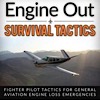11 Dec 2025, 09:17 [ UTC - 5; DST ]
|

|
Username Protected
|
Post subject: Re: Parachute pressure  Posted: Posted: 25 Jan 2013, 10:23 |
|
 |

|
|
 |

Joined: 04/04/12
Posts: 2377
Post Likes: +561
Location: O32 Central Cali.
Aircraft: C150
|
|
Perhaps one day there will be a fixall. But in aviation math it will consume one side of the cost versus benefit. I like the safety backup of Cirrus. They are nice machines. We all minimize risks in otherways. I had a guy ride back to the homefield in a 172 because my plane has the famously dangerous V tail. 25  thats young in BT years, you have alot of great experience in that amount of time.
|
|
| Top |
|
|
Username Protected
|
Post subject: Re: Parachute pressure  Posted: Posted: 25 Jan 2013, 11:43 |
|
 |

|
|
 |

Joined: 11/21/09
Posts: 12493
Post Likes: +17172
Location: Albany, TX
Aircraft: Prior SR22T,V35B,182
|
|
$1k per year is pretty dang cheap in airplane money.  A lot cheaper than carrying around (and caring for) a second engine. Username Protected wrote: 10,000$ at least every 10 years for repacking is mighty negative. Carrying it around too, I'd rather have AC... or fuel for that weight, if safety is important.
|
|
| Top |
|
|
Username Protected
|
Post subject: Re: Parachute pressure  Posted: Posted: 25 Jan 2013, 12:39 |
|
 |

|
|
 |

Joined: 05/17/11
Posts: 1878
Post Likes: +1322
Location: KFRG
Aircraft: 421C
|
|
Username Protected wrote: I just don't understand how having the chute is actually a negative in the eyes of so many pilots. It doesn't make any sense. If you don't care for the chute, ok then don't use/pull it. Fly the plane right down to wherever your emergency puts you. For me, I view it as one more option to have if you get into trouble... AND anyone can get into trouble; to think otherwise is silly. 10,000$ at least every 10 years for repacking is mighty negative. Carrying it around too, I'd rather have AC... or fuel for that weight, if safety is important.
Have an engine failure over residential NY at 2000 feet with the closest airport being 5 miles away and let me know how that extra fuel and AC are doing keeping you cool on the way down. 
|
|
| Top |
|
|
Username Protected
|
Post subject: Re: Parachute pressure  Posted: Posted: 25 Jan 2013, 15:03 |
|
 |

|
|
 |

Joined: 11/06/10
Posts: 12196
Post Likes: +3078
Company: Looking
Location: Outside Boston, or some hotel somewhere
Aircraft: None
|
|
|
I think this whole thread is kinda funny.
For some the parachute like a second engine is an emotional item.
Others try and use logic to get to the point.
Others look at like insurance.
At the end of the day, the chute presents options. Good and bad. Like many things, how the pilot / user makes or justifies the chute and if it affects the flying may be good or bad.
So for all those which have insurance but state the chute is a bad idea. How can you justify one and not the other? They both offer additional protection.
For all those which state they would rather spend the 1K a year annual ammoratized cost of the chute on training. Why not skip insurance and spend the money on additional training, it will reduce your risks?
For those that state they only fly day VFR in a single. Look at the crash reports, you are more likely to crash and/or have a fatal accident. More crashes are VMC (I am including scud running here) than IMC; since the pilot is the major weakness, focus on yur skills and fly the heck out of the airplane.
Most of flying is about risk mitigation. Pick your risks, I like to fly at night, IMC does not really matter to me. Therefore I want a fall back option in case it goes to hell in a hand basket. I know I am the most likely failure point. I therefore retrain as much as possible (I prefer a refresher flight every few months -- due for one now actually). The chute is a significantly cheaper fallback option compared to a second engine.
Lastly, as part of risk mitigation, consider where you fly. If I mostly flew over the midwest with the farms and rolling hills, that would be one thing. But I fly a lot over cities and the small mountains on the east. The condition of the land affects a lot of pilots appreciation or lack there of for what risks he/she is comfortable with.
Tim
|
|
| Top |
|
|
Username Protected
|
Post subject: Re: Parachute pressure  Posted: Posted: 25 Jan 2013, 15:11 |
|
 |

|
|

Joined: 11/22/08
Posts: 3115
Post Likes: +1071
Company: USAF Propulsion Laboratory
Location: Dayton, OH
Aircraft: PA24, AEST 680, 421
|
|
Username Protected wrote: A twin turbo prop with a parachute may be the best answer short of a jet. Anybody know of a parachute STC for a Royal Turbine Duke?  You don't need one! the Royal Turbine has so much excess power you would be tempted to just fly on to your destination or a appropriately chosen maintenance facility on 1 engine.. 
I thought those Royal Duke guys flew around most of the time on one engine just to show off....and pass the occasional cessna.
|
|
| Top |
|
|
Username Protected
|
Post subject: Re: Parachute pressure  Posted: Posted: 25 Jan 2013, 21:53 |
|
 |

|

|
 |

Joined: 12/10/07
Posts: 8231
Post Likes: +7967
Location: New York, NY
Aircraft: Debonair C33A
|
|
Username Protected wrote: So far, the safety record of the SR22 has not been better than comparable legacy airframes like Mooneys, Bonanzas or Comanches. Depending on how you select your data, it is arguably worse. Cirrus points to all these 'saves', if one took those 'saves' at a fatality rate of 30%, the safety record of the SR22 would probably be considerably worse than the legacy airframes. Now, the great majority of GA accidents are the result of general purpose pilot knuckleheadedness, the Cirri are no exception. So the influence of technical factors on the overall fatality rate is going to be limited. If 8.5 out of 10 accidents are caused by the nut that holds the sidestick, you are going to have more influence on the accident rate if you improve training.
Here is how I look at it. With careful planning and good judgment I can avoid the conditions which lead to these 85% of accidents. No matter how good a pilot I am, however, there are things I can't control, like engine failures over inhospitable terrain, mid-airs, and control surface failures. Coincidentally, the chute is a great tool for these situations. If you are a prudent, safe pilot and fly a BRS-equipped plane, your risk exposure is pretty much limited to the first 500 ft of the climb. That must be a comforting feeling.
|
|
| Top |
|
|
Username Protected
|
Post subject: Re: Parachute pressure  Posted: Posted: 25 Jan 2013, 23:04 |
|
 |

|
|
 |

Joined: 07/07/10
Posts: 4233
Post Likes: +1339
Company: USAF(RET) Lockheed Martin
Location: Ft Worth
|
|
Username Protected wrote:
If you are a prudent, safe pilot and fly a BRS-equipped plane, your risk exposure is pretty much limited to the first 500 ft of the climb. That must be a comforting feeling.
And below 133 KIAS not out of control.
_________________
Engine Out Survival Tactics
paperback & eBook
|
|
| Top |
|
|
Username Protected
|
Post subject: Re: Parachute pressure  Posted: Posted: 26 Jan 2013, 00:08 |
|
 |

|

|
 |

Joined: 12/10/07
Posts: 8231
Post Likes: +7967
Location: New York, NY
Aircraft: Debonair C33A
|
|
Username Protected wrote:
If you are a prudent, safe pilot and fly a BRS-equipped plane, your risk exposure is pretty much limited to the first 500 ft of the climb. That must be a comforting feeling.
And below 133 KIAS not out of control.
Below 133 KIAS, yes. Out of control, not necessarily. It will recover very well from a spin or some disorderly tumbling like one could encounter in a mid-air. High speed dive or spiral - not so much (because of the 133 KIAS thing).
|
|
| Top |
|
|
Username Protected
|
Post subject: Re: Parachute pressure  Posted: Posted: 27 Jan 2013, 08:08 |
|
 |

|
|
 |

Joined: 05/13/08
Posts: 1248
Post Likes: +1094
Location: KOUN - Norman, OK
Aircraft: Sneakers
|
|
a friend of mine is looking at a new or newer airplanes and had this to say about his recent demo flight in a cirrus. Quote: Test drove a brand spakin new Cirrus SR22 G3 Turbo. Really nice planes. It's pretty much crash proof. It won't let you invert it, stall it, or get disoriented. And if some how your stupid enough to find a way to get in a bind I'm this plane, just pull the rocket powered parachute and the while phone will float back down to the ground. Pretty amazing technology in general aviation today.
I think a Cirrus is in my future Growing up I always heard that 4 wheel drive will only get you stuck further out. I wonder with some pilots if the Cirrus parachute is the same. This same friend of mine sank his pickup in the Canadian river just south of Norman one cold January night.
|
|
| Top |
|
|
Username Protected
|
Post subject: Re: Parachute pressure  Posted: Posted: 27 Jan 2013, 08:47 |
|
 |

|
|

Joined: 04/06/08
Posts: 2718
Post Likes: +100
Location: Palm Beach, Florida F45
|
|
|
In a fixed gear airplane, a parachute really does have a purpose. If you have a forced landing in a muddy field, you're probably going to flip. Many deaths (and serious injuries) might not have occurred if not for the flip.
In the earlier days of Cirrus, Columbia was a serious competitor, and they were both fighting to be the composite, single piston leader. In that case the Cirrus won, and the parachute was an important reason. Flipping is one reason I didn't buy a Columbia, although I really preferred the way they fly.
Bonanzas give you the choice of a gear up and a belly landing in mud or water, and a decent likelihood of staying upright. Maybe that's why Beech owners are splitting hairs on the parachute idea?
I'll bet most of us would prefer a parachute over a flip!
|
|
| Top |
|
|
Username Protected
|
Post subject: Re: Parachute pressure  Posted: Posted: 27 Jan 2013, 10:01 |
|
 |

|
|
 |

Joined: 11/02/10
Posts: 3483
Post Likes: +212
Company: T303, T210, Citabria
Location: Houston, TX
Aircraft: 1968 Bonanza E33
|
|
Username Protected wrote: - Just after departure in a twin fully loaded with climbing terrain.
Not if it has the full Robertson package.....
_________________
無為而治 世界大同
individual sovereignty universal harmony
|
|
| Top |
|
|
Username Protected
|
Post subject: Re: Parachute pressure  Posted: Posted: 27 Jan 2013, 12:29 |
|
 |

|
|
 |

Joined: 11/06/10
Posts: 12196
Post Likes: +3078
Company: Looking
Location: Outside Boston, or some hotel somewhere
Aircraft: None
|
|
Username Protected wrote: There's a lot of talk about the chute providing options.
I feel that in most cases it is possible to fly in a way that would leave one with options should one loose the engine in a traditional single.
However, regardless what you drive, if the incident occurs at the worst possible moment, it will leave you without options.
E.g.:
- Just after departure in a twin fully loaded with climbing terrain.
- In a single on top over mountainous terrain.
- IMC in a Cirrus without enough altitude to execute the chute (departure or approach).
I think the only way to get entirely risk free flying is to use a sim. Arne, Just FYI, for the Cirrus, that is less than 500ft AGL. If Approach, continue to land you should be dam close. If on take off, you land straight ahead as with an other single -- but you are unable to pull the chute for just a very short period. Tim
|
|
| Top |
|

|
You cannot post new topics in this forum
You cannot reply to topics in this forum
You cannot edit your posts in this forum
You cannot delete your posts in this forum
You cannot post attachments in this forum
|

Terms of Service | Forum FAQ | Contact Us
BeechTalk, LLC is the quintessential Beechcraft Owners & Pilots Group providing a
forum for the discussion of technical, practical, and entertaining issues relating to all Beech aircraft. These include
the Bonanza (both V-tail and straight-tail models), Baron, Debonair, Duke, Twin Bonanza, King Air, Sierra, Skipper, Sport, Sundowner,
Musketeer, Travel Air, Starship, Queen Air, BeechJet, and Premier lines of airplanes, turboprops, and turbojets.
BeechTalk, LLC is not affiliated or endorsed by the Beechcraft Corporation, its subsidiaries, or affiliates.
Beechcraft™, King Air™, and Travel Air™ are the registered trademarks of the Beechcraft Corporation.
Copyright© BeechTalk, LLC 2007-2025
|
|
|
|



